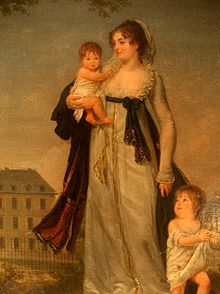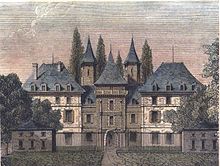Aimée Davout
Aimée Davout , née Louise-Aimée-Julie Leclerc (born June 16, 1782 in Pontoise , today's Val-d'Oise , Burgundy ; † December 16, 1868 in Paris ) came from a wealthy French bourgeoisie. Many times her family's paths crossed those of the Napoleon Bonaparte family . In the 86 years of her life she witnessed great events in French history.
origin
Aimée Leclerc was born on June 16, 1782 as the daughter of Marie Jeanne Musquinet (* 1743) and Jean-Paul Leclerc (1735–1790) in Pontoise. Her father ran a large grain and salt warehouse and had the royal privilege of trading in salt. He had made his fortune before the revolution. Aimée was the fourth and last child of her parents. Her siblings were Jean Louis Leclerc (1767–1822), Jean (died in early childhood), Nicolas Marin Leclerc (1770–1820), Victoire Emmanuel Leclerc (1772–1802, ⚭ Pauline Bonaparte ) and Françoise Charlotte (1776–1853, ⚭ General Louis de Friant ).
Childhood and youth
Aimée Leclerc's childhood was shaped by the French Revolution. Aimée attended the parish school in the only church in Pontoise that had not been destroyed or turned into stables. The sansculottes had not only destroyed churches, but also plundered Jean-Paul Leclerc's salt and granaries. Things that were reminiscent of the old regime were burned in a public festival. An infantry regiment restored order in Pontoise. The destruction of his life's work possibly led to the sudden death of Aimée Leclerc's father at the age of 55. Aimées brother Victoire Emmanuel Leclerc took over the role of head of the family and became the guardian of Aimées.
From the age of 15, Aimée Leclerc was trained at the Campan girls' boarding school in Saint-Germain-en-Laye . The boarding house was founded in 1794 by Henriette Campan , Marie Antoinette's former chambermaid . The daughters of rich bourgeois and noble families were educated here. Caroline Bonaparte , a younger sister of Napoleon, and Hortense de Beauharnais , daughter of Joséphine de Beauharnais , attended the boarding school at the same time as Aimée Leclerc.
marriage
Aimée's brother, General Victoire Emmanuel Leclerc, was a brother-in-law of Napoleon . In 1801, Leclerc was commissioned by Napoleon to break into the French part of the island of Hispaniola ( Santo Domingo ) with an invading army in order to overthrow the black general Toussaint Louverture . Since Leclerc was expecting an absence of several years, he wanted to know that his youngest sister's future was secure. He had made friends with General Louis-Nicolas Davout during the Egypt campaign . Davout came from old Burgundian nobility and had an excellent position in the military. Leclerc introduced his 19-year-old sister to 31-year-old Davout. The two took a liking to each other. The wedding took place on November 9, 1801 in Paris in the presence of Napoleon Bonaparte and his wife Joséphine de Beauharnais.
Family life in wartime
In Santo Domingo, General Leclerc , Aimée Davout's brother, fell ill with yellow fever and died to the sorrow of the whole family on November 2, 1802. Aimée Davout saw the fault with Napoleon, who had poorly provided for his troops in Santo Domingo. With General Leclerc, 22,000 of his soldiers had died of yellow fever.
The wars that Napoleon waged in Europe determined the family life of the Davouts. During the first 14 years of their marriage, Aimée and Louis-Nicolas Davout lived mostly separately from each other. France was not at war for only 18 months during this period. Letters went back and forth between the spouses almost every day during these years. Some of the letters have survived and show two people who were very fond of each other. All everyday things were also discussed between them by letter.
Aimée Davout did not share Louis-Nicolas Davout's devotion to Napoleon. She was more sympathetic to Joséphine Bonaparte, the godmother of Aimée and Louis Nicolas Davout's first daughter. The child died a year later. The subsequent daughter was also named Joséphine. A later born son was named Napoleon.
Since Louis-Nicolas Davout was rarely given leave of absence from his services, Aimée Davout was allowed to visit him several times at the places of his stationing with Napoleon's consent. In December 1803 she traveled to Bruges and stayed there until January 1804. At that time, Napoleon had the entire coast of the English Channel controlled. In 1808, Aimée Davout and her daughters Joséphine and Adèle visited her husband in Poznan and Warsaw. Davout was Lieutenant Governor of Poland at the time. Aimée Davout went to Vienna in 1809. Marshal Davout had previously successfully defeated the Austrian troops on April 22, 1809 near Eggmühl (formerly Eckmühl). Later he was appointed Prince of Eckmühl and Duke of Auerstedt by Napoleon . As was customary in those days, the wife also bore this title. Aimée Davout became La Maréchale , Princesse d'Eckmühl and Duchesse d'Auerstedt . However, no property in Eckmühl or Auerstedt was associated with these titles. After the Russian campaign, from which Davout had returned alive with only a few of his soldiers, Aimée Davout visited him in Stettin in 1812.
In the years from 1806 to 1814 the Hanseatic city of Hamburg was occupied by Napoleonic troops. Louis Nicolas Davout became Governor General of the Hanseatic Departments in 1810, based in Hamburg. Aimée Davout followed him there with their two daughters. They stayed from July 21 to August 12, 1813 and lived in a country house in Hamburg-Hamm during this time.
Life in Savigny and Paris
At the beginning of their marriage, Aimée and Nicolas Louis Davout lived in Paris in a wing of the Tuileries . Since Aimée Davout was very averse to both court life and city life, the two acquired a castle in Savigny-sur-Orge in 1802 , which would be the center of their life for the next few decades. Thanks to financial donations from Napoleon, they were able to acquire the Hôtel de Monaco in the Rue Dominique in Paris in January 1808, where they could fulfill their representative duties. At the coronation of Napoleon as emperor (December 2, 1804), Aimée and Louis-Nicolas Davout were among the guests in the Notre Dame Cathedral . But Aimée Davout turned down the offer to become lady-in-waiting to Madame Mère , Napoleon's mother, in 1805, giving reasons for health. In several letters she had discussed this decision with her husband and decided against it. After the divorce from Joséphine, Napoleon married Marie Louise , daughter of the Austrian emperor, in 1810 . Louis Nicolas Davout traveled to Compiègne with Napoleon to pick up the 18-year-old bride. Although Aimée Davout was outraged by Napoleon's divorce from Joséphine de Beauharnais, she could not evade her obligations and attended the reception of the young bride. The dress that Aimée Davout wore during the reception can still be admired in the Auxerre Museum in the Salle Eckmühl .
The time of separation came to an end for the married couple Aimée and Louis Nicolas Davout in 1814. Napoleon had abdicated and was banished to the island of Elba . A short time afterwards, Davout handed over the occupied city of Hamburg and returned to France. When Napoleon left Elba in 1815 to take power again in France, he persuaded Davout to take over the office of Minister of War. In August, Napoleon's rule of the Hundred Days ended . Davout was exiled to Louviers on December 27, 1815 . During his exile, the family had no income as Davout's earnings had been cut. The claim to property abroad, which Davout had received from Napoleon, was lost. After half a year, Aimée Davout's efforts to bring about freedom for her husband were finally successful. Davout was able to return to his family in Savigny on June 21, 1816. King Louis XVIII finally granted Davout his earnings again and appointed him Marshal of France.
Louis-Nicolas Davout died in Paris on June 18, 1823 at the age of 53. Aimée Davout then lived mainly in Savigny and only spent the winters in Paris. After the death of King Louis XVIII, his brother Charles X succeeded him to the throne. Although invited, Aimée Davout waived the honor of attending the coronation ceremonies in Reims Cathedral . In doing so, she remained true to her aversion to court life.
Many years later there was another encounter with the Bonaparte family. In 1856, Aimée Davout's grandson, Louis de Cambacérès, married a great-niece of Napoleon, Bathilde Aloïse Léonie Bonaparte. The young woman died at the age of 20 and had two children.
Aimée Davout died on December 16, 1868 at the age of 86 in her home in Paris. The grave of Louis-Nicolas and Aimée Davout and their daughter Antoinette Joséphine is in the Père Lachaise cemetery in Division 28.
The youngest daughter Adélaïde-Louise d'Eckmühl de Blocqueville published a biography and her father's letters in 1879.
progeny
Aimée and Louis-Nicolas Davout had eight children, four of whom died in early childhood.
- Paul (August 1802 † August 1803)
- Joséphine (May 1804 † June 1805)
- Antoinette Joséphine (* August 1805 † 1821, ⚭ 1820 Achille Félix-Vigier)
- Adèle Napoleone (* June 1807 † January 21, 1885, ⚭ 1827 Etienne Armand Napoleon de Cambacérès)
- Napoleon (February 1809 † June 1810)
- Louis Napoleon (born January 6, 1811 † June 13, 1853, 2nd Duke of Auerstedt, 2nd Prince of Eckmühl)
- Jules (December 1812 † 1813)
- Adélaïde-Louise (* 1815 † 1892, writer, editor of her father's letters. ⚭ August 17, 1835 François-Edmond de Couliboeuf, Marquis de Blocqueville)
literature
- Marie-José Chavenon: Aimée Davout . Marechale et Princesse. Louis, Haroué 2013, ISBN 978-2-35763-049-9 .
- Gabriele Hoffmann : The ice fortress . Hamburg in the cold grip of Napoleon. Piper, Munich 2013, ISBN 978-3-492-30183-1 .
- John G. Gallaher: The iron marshal . A biography of Louis N. Davout. Greenhill Books, London 2000, ISBN 1-85367-396-X .
- Alain Felkel : Louis Nicolas Davout . The genius behind Napoleon's victories. Osburg, Hamburg 2013, ISBN 978-3-95510-026-1 .
- Louise Adélaïde de Blocqueville: Le Maréchal Davout, prince d'Eckmühl . raconté par les siens et par lui-même. Didier, Paris 1879, OCLC 69053646 .
Web links
Individual evidence
- ↑ Louise Adélaide de Blocqueville: Le Maréchal Davout, prince d'Eckmühl: raconté par les siens et par lui-même . Paris 1879
| personal data | |
|---|---|
| SURNAME | Davout, Aimée |
| ALTERNATIVE NAMES | Leclerc, Louise-Aimée-Julie (maiden name); Davout, Aimee |
| BRIEF DESCRIPTION | Contemporary witness of great events in French history |
| DATE OF BIRTH | June 16, 1782 |
| PLACE OF BIRTH | Pontoise , Burgundy |
| DATE OF DEATH | December 16, 1868 |
| Place of death | Paris |





